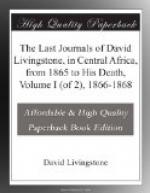Hamees is on friendly terms with a tribe of Mazitu who say that they have given up killing people. They lifted a great many cattle, but have very few now; some of them came with him to show the way to Kasonso’s.
Slaves are sold here in the same open way that the business is carried on in Zanzibar slave-market. A man goes about calling out the price he wants for the slave, who walks behind him; if a woman, she is taken into a hut to be examined in a state of nudity.
Some of the Arabs believe that meteoric stones are thrown at Satan for his wickedness. They believe that cannon were taken up Kilimanjaro by the first Arabs who came into the country, and there they lie. They deny that Van der Decken did more than go round a portion of the base of the mountain; he could not get on the mass of the mountain: all his donkeys and some of his men died by the cold. Hamees seems to be Cooley’s great geographical oracle!
The information one can cull from the Arabs respecting the country on the north-west is very indefinite. They magnify the difficulties in the way by tales of the cannibal tribes, where anyone dying is bought and no one ever buried, but this does not agree with the fact, which also is asserted, that the cannibals have plenty of sheep and goats. The Rua is about ten days west of Tanganyika, and five days beyond it a lake or river ten miles broad is reached; it is said to be called Logarawa. All the water flows northwards, but no reliance can be placed on the statements. Kiombo is said to be chief of Rua country.
Another man asserts that Tanganyika flows northwards and forms a large water beyond Uganda, but no dependence can be placed on the statements of these half Arabs; they pay no attention to anything but ivory and food.
25th August, 1867.—Nsama requested the Arabs to give back his son who was captured; some difficulty was made about this by his captor, but Hamees succeeded in getting him and about nine others, and they are sent off to-day. We wait only for the people, who are scattered about the country. Hamees presented cakes, flour, a fowl and leg of goat, with a piece of eland meat: this animal goes by the same name here as at Kolobeng—“Pofu."[56]
A fig-tree here has large knobs on the bark, like some species of acacia; and another looks like the Malolo of the Zambesi magnified. A yellow wood gives an odour like incense when burned.
A large spider makes a nest inside the huts. It consists of a piece of pure white paper, an inch and a half broad, stuck flat on the wall; under this some forty or fifty eggs are placed, and then a quarter of an inch of thinner paper is put round it, apparently to fasten the first firmly. When making the paper the spider moves itself over the surface in wavy lines; she then sits on it with her eight legs spread over all for three weeks continuously, catching and eating any insects, as cockroaches, that come near her nest. After three weeks she leaves it to hunt for food, but always returns at night: the natives do not molest it.




